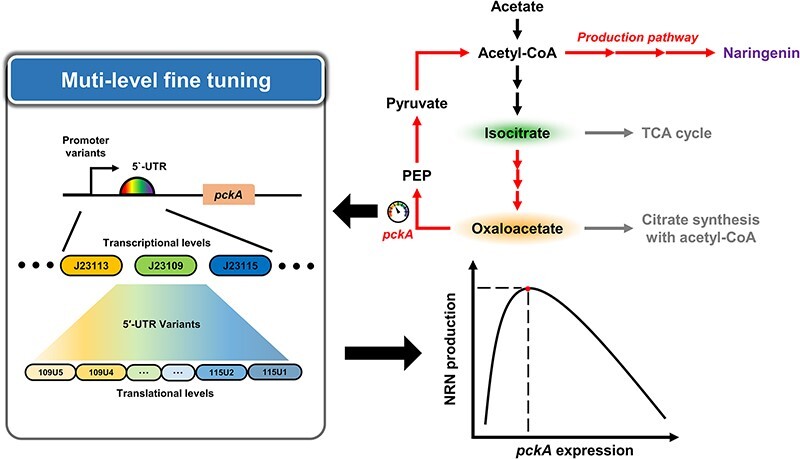- Record: found
- Abstract: found
- Article: found
Transcriptional and translational flux optimization at the key regulatory node for enhanced production of naringenin using acetate in engineered Escherichia coli

Read this article at
Abstract
As a key molecular scaffold for various flavonoids, naringenin is a value-added chemical with broad pharmaceutical applicability. For efficient production of naringenin from acetate, it is crucial to precisely regulate the carbon flux of the oxaloacetate-phosphoenolpyruvate (OAA-PEP) regulatory node through appropriate pckA expression control, as excessive overexpression of pckA can cause extensive loss of OAA and metabolic imbalance. However, considering the critical impact of pckA on naringenin biosynthesis, the conventional strategy of transcriptional regulation of gene expression is limited in its ability to cover the large and balanced solution space. To overcome this hurdle, in this study, pckA expression was fine-tuned at both the transcriptional and translational levels in a combinatorial expression library for the precise exploration of optimal naringenin production from acetate. Additionally, we identified the effects of regulating pckA expression by validating the correlation between phosphoenolpyruvate kinase (PCK) activity and naringenin production. As a result, the flux-optimized strain exhibited a 49.8-fold increase compared with the unoptimized strain, producing 122.12 mg/L of naringenin. Collectively, this study demonstrated the significance of transcriptional and translational flux rebalancing at the key regulatory node, proposing a pivotal metabolic engineering strategy for the biosynthesis of various flavonoids derived from naringenin using acetate.
Graphical Abstract
Related collections
Most cited references37
- Record: found
- Abstract: found
- Article: not found
One-step inactivation of chromosomal genes in Escherichia coli K-12 using PCR products.
- Record: found
- Abstract: found
- Article: not found
Synthetic biology: new engineering rules for an emerging discipline

- Record: found
- Abstract: found
- Article: found
